Top 5 Technology Problems for Associations and How To Fix Them

The five common technology problems impacting associations include upgrade delays, customizations, using too many one-off systems, point-to-point integrations, and on-premise servers. Organizations can reduce the impact of these IT issues by managing so-called “technical debt” and balancing quality, time, and cost.
All organizations experience problems with the effectiveness of technology when speed and costs are prioritized at the expense of quality. “I need to get to market faster. I need a cheaper solution. I don't have enough money or time for that right now.”
These are the common “must-haves” we hear and the trade-offs associations make that lead you down the long and winding rabbit hole of what we call “technical debt.”
We always intend to go back and address these technology problems. But oftentimes it doesn't happen and the cost of those technical compromises keeps accumulating, just like credit card debt.
What’s scary is that the repercussions often go unnoticed until you’re hit with an unexpected event, such as the recent pandemic, or until you can’t make necessary digital transformations. But every day that you ignore problems with your technology, the “interest” and “balance” on technical debt can take a toll on your organization and mission.
It becomes a bigger problem when the cost of transformation isn’t included in your IT budget. According to a report from Gartner, organizations often put the vast majority of budget for IT into platform operations - more than 70 percent on average. That operational expense has grown over time, leaving less and less available for innovation.
What is technical debt?
Technical debt is the cost of making a less than optimal decision today over a more optimal solution tomorrow.
![]()
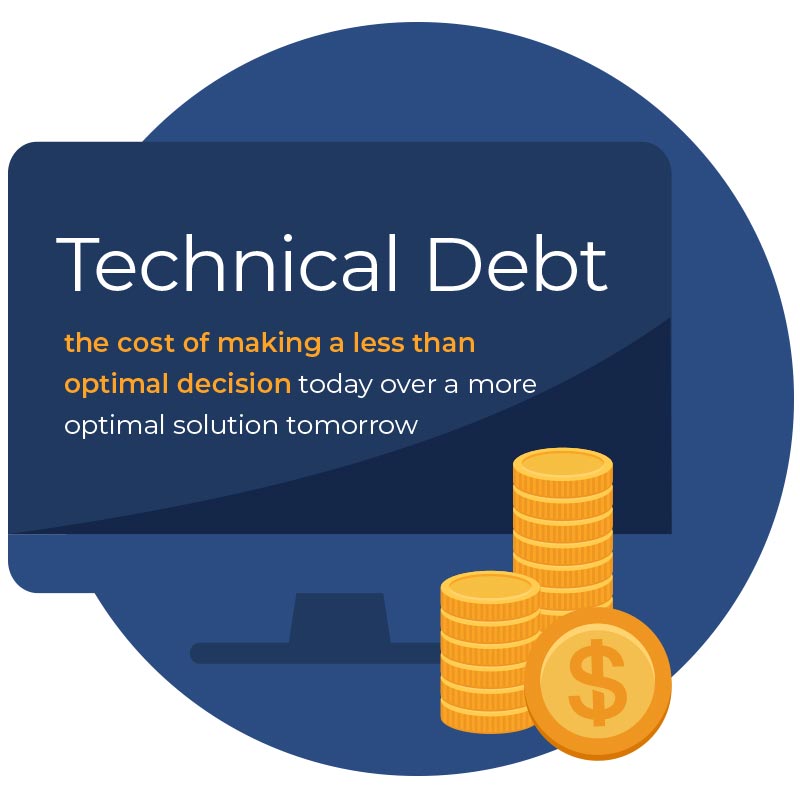
Whether it’s because you couldn’t afford to do something or you didn’t have enough time, technical debt is essentially the work you must do tomorrow because you took a shortcut today.
When I was first starting my career, I was taught that there are three important factors of pretty much everything we do on projects:
- Time
- Cost
- Quality
You can think of everything you do, especially in the technical world, like a three-legged stool in which time, cost, and quality are the three supporting legs. And these legs or components are interlaced and all locked to each other.
IT projects are like a three-legged stool in which time, cost, and quality are interdependent.
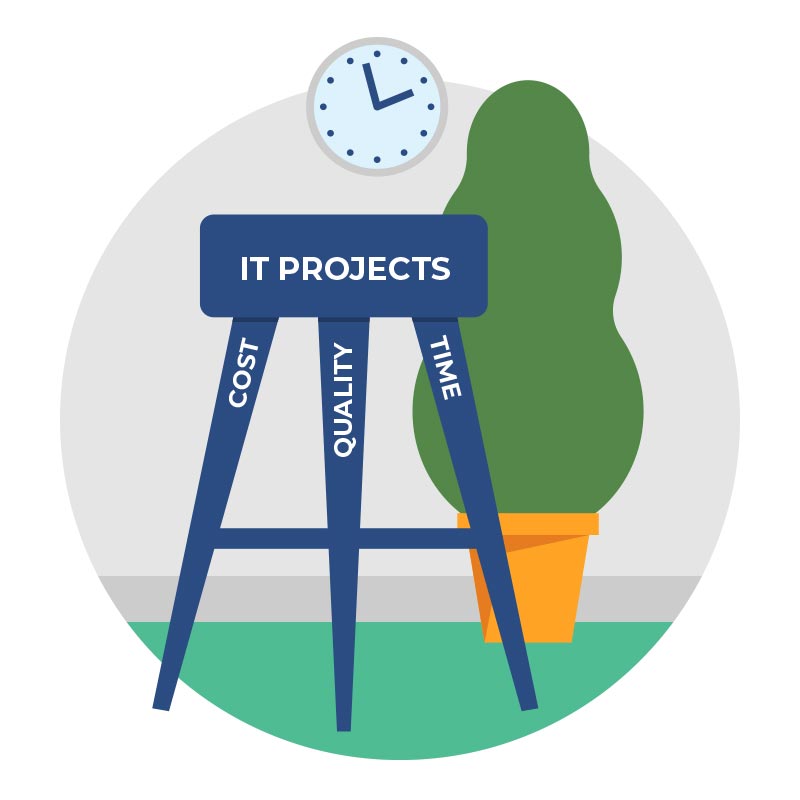
When we compromise on any of these three elements, we accumulate technical debt and risk a failure to meet our long-term goals.
For example, when you compromise on quality for the sake of speed or costs, you’ll end up having to pay for it later. And if you compromise on time or money, then you’re less likely to achieve the best quality.
Often associations rush through something and undermine quality with the intention of “we’ll get to that later”. But most organizations don't really think about the consequences of these technology problems until they boil over into a volcano of trouble.
It’s a common problem. In a survey of CIOs conducted by McKinsey Digital in 2020, 60 percent reported feeling a perceptible increase in technical debt in the last 3 years.
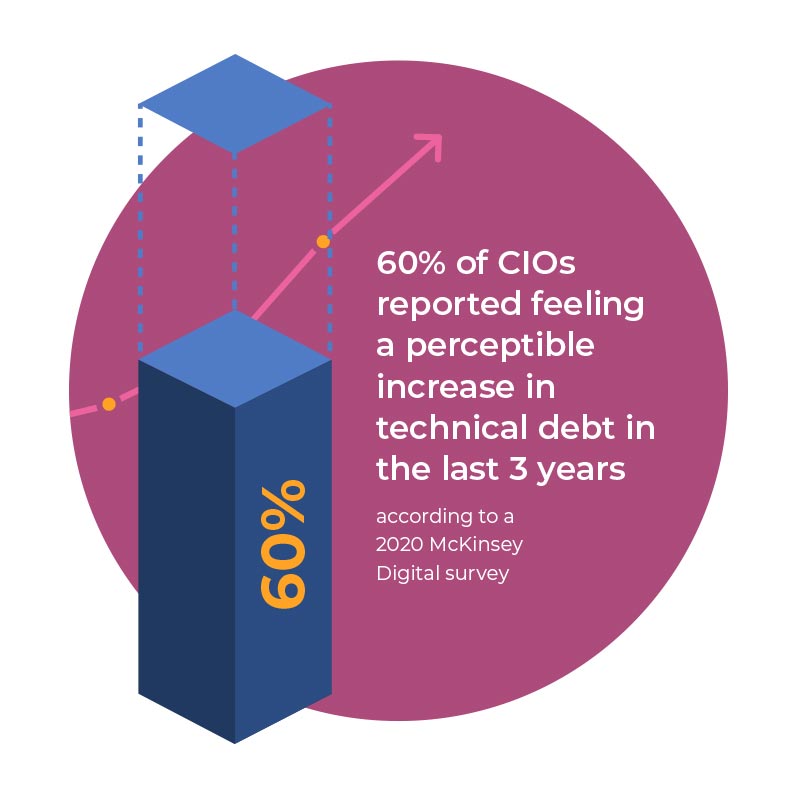
Top 5 Technology Problems for Associations
There are five main types of problems with technology that organizations encounter that end up turning into technical debt.
Problem #1: Delaying Upgrades
System upgrades often get put off in the association world. It’s like when you buy a piece of software or an application on your iPhone. That application needs to be upgraded sooner or later, right? If you don’t, the application may not be supported or functional. This is the same for association applications.
But many associations defer upgrading applications or infrastructure because there may be a cost or it may require significant effort to do so. It’s often not as simple as pushing the upgrade button on your smartphone.
If you keep up with upgrades, it's much simpler to make transitions. On the other hand, If you delay five upgrades then you’ll suddenly be staring down this big, more costly upgrade that you need to accomplish before you can get on with your plan.
Problem #2: Software Customizations
Customization is when you take a piece of off-the-shelf software and then try to make things happen that are outside of what the software is engineered to do.
If you customize your software, you run the risk of those modifications not fitting well with the next upgrade. At that point, you won’t be able to upgrade your software unless you pay the vendor again for your customization. At Cimatri, we call it the ‘vendor annuity plan’.
Many associations believe that they're too unique to fit a piece of packaged software. But the truth is, most organizations nowadays are trying to avoid customization at all costs because it roadblocks you from making the next upgrade.
The more customizations you have, the more likely you are to have accumulated a lot of technical debt that will need to be addressed either at the time you upgrade or when you attempt to integrate with other systems.
Problem #3: Too Many Systems
Some associations rack up too many applications over time without having a solid strategy for which technologies to use.
For example, we have one client that was using 172 applications. 172! Over the years, the organization started using more and more applications because team members were picking their own solutions.
So although everyone had what they needed at the moment, the organization as a whole accumulated quite a bit of technical debt and overhead costs.
Problem #4: One-to-One Integrations
Instead of using one platform to integrate all systems, many associations build one-off, point-to-point integrations.
In other words, they have one integration between two systems and then another integration between another two systems, so on and so forth.
Instead, it’s better to have one seamless integration platform for all systems. This is where application programming interfaces and microservices fit into your strategy. This approach eliminates the ‘spider web’ of point-to-point interfaces that are very difficult to document, test, and replicate during a system change or upgrade.
Problem #5: Not Moving to the Cloud
Most organizations used to run all of their infrastructure “on-premise.” This means they built servers and hired system administrators to maintain them (which is a kind of operational waste in and of itself). Associations would run their infrastructure on-premise because the cloud wasn’t as mature 5-10 years ago.
When you maintain on-premise servers, you’re basically “keeping the lights blinking” in some server room. But today, everything we need is now available to buy from cloud services.
Cloud vendors tend to do a much better job of keeping those lights blinking than we could ever do individually as organizations. As an added bonus, much of the heavy lifting on cybersecurity is included in their service. Unfortunately, some associations still have yet to transition to cloud services and are still watching those blinking lights.
Examples of Association Tech Challenges
There are many examples of technical waste and operational challenges impacting associations that stem from upgrade delays, customizations, using too many one-off systems, point-to-point integrations, and on-premise servers.
A lot of these issues come down to a fundamental lack of strategy.
Lack of Strategy
Consider what happened to everybody during COVID. Before the pandemic, many people didn't have a work-from-home strategy, enough in-home bandwidth, or the right contingency planning. COVID changed the game as people had to pivot to remote work. It was a HUGE disrupter.
Whatever was spent to give people the ability to work from home is technical debt that had accumulated over many years.
The same goes for events. People have been spending loads of money to make virtual and hybrid events work when, in reality, the association world has been talking about these kinds of remote events for the past 10 years.
This is a great example of how waiting for a catalyst, disruption, or structural break will cause you to amass technical liabilities that will cost more in the end. It’s the same as having your credit line suddenly called in by your bank.
Software Customization (aka ‘the Vendor Annuity Plan’)
One software customization may cost you around $50,000, right? But as I mentioned earlier, if that customization is not on the product roadmap for your vendor’s next round of upgrades, then you'll have to pay that same vendor another $50,000 at the time of their next release to do that same customization.
Customizations are almost like an annuity program for the vendor. Every time you need to upgrade, they're going to get $50,000, or whatever the figure is, to do the customization, and most application vendors upgrade on a one- or a two-year cycle.
So every year or two, you're going to pay that vendor that same amount (or more). And if you don’t upgrade, it could compromise your system's ability to “talk to” other systems.
On-Premise Disasters
Now let’s circle back to technology problems related to on-premise hosting to look at a recent example.
In early 2021, the on-premise Microsoft Exchange Server platform was hacked. This left more than 30,000 organizations vulnerable because they hadn’t moved to the cloud. These organizations were still using old, on-premise architecture and had system administrators running their own security platforms.
By not switching to these really great cloud products that the vendor now provides as a service, these organizations accumulated costly technical setbacks that came back to haunt them.
That’s why at Cimatri, we’ve made the choice not to be a traditional managed service provider because we don’t want to inadvertently encourage the accumulation of technical debt. Instead, we recommend the right cloud service providers for your individual situation and work to eliminate the ‘blinking lights’ in your server room.
By the way, if you are using one of the traditional managed service providers or co-location providers, you are still managing those pesky ‘blinking lights.'
Read More: Why Cloud-Based Services Are Critical for Associations
How to analyze your IT issues
You analyze IT problems just like you would credit card debt. The first step is quantifying it. You have to know that it's there, right?
The first step to analyzing technical debt is quantifying it.
 That’s why one of the first things we look at when conducting an assessment is the list of customizations a client has made to their software products. Custom modifications are most commonly made to Association Management System (AMS) platforms, the core system for most associations.
That’s why one of the first things we look at when conducting an assessment is the list of customizations a client has made to their software products. Custom modifications are most commonly made to Association Management System (AMS) platforms, the core system for most associations.
We’ll ask, “can you tell me all the customizations you've made to your AMS over the years?” Putting a dollar amount to this list is a good way to start analyzing the cost of questionable technical decisions.
How are IT debt problems quantified?
You can calculate the impact of technology problems by first identifying whatever “got you into debt.” Then you have to measure how much these issues are costing you now as well as how much they’re holding you back.
To simplify this, let’s go back to our customization example. Say you make $50,000 worth of customizations to your AMS system and your AMS vendor upgrades on a two-year cycle. But you defer those upgrades for five years. So in a five-year window, if your vendor upgrades twice, then you’ll have to spend $100,000 on customization. $50,000 for each of the two upgrades to become current.
There’s another factor you have to consider when measuring technology issues: opportunity costs. This opportunity cost is a little more difficult to calculate. Opportunity cost considers what you’re not able to do because of technical debt.
Let’s say the $50,000 you spent on customizations prohibits you from securing a thousand new members. Whatever those thousand members would have generated for you in revenue is an opportunity cost that should be included in your overall calculation.
So, in short, you have to calculate what you spent on the customization in the first place (the “hard” cost), the subsequent cost of customization to keep up with the upgrade cycle (the recurring costs), and whatever opportunities this debt has hindered you from doing (the opportunity cost).
Technical debt = cost of initial poor tech decision + recurring costs + opportunity cost
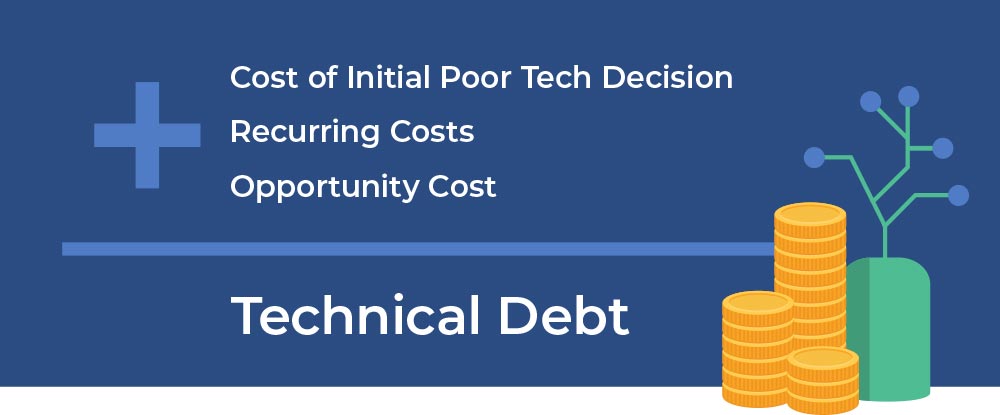
As you can see, there's a lot of different ways to calculate the cost of poor decisions related to technology. However, most people don't consider measuring this technical waste. But adding it all up and giving it a dollar amount allows you to see “under the hood” of your technology choices and the impact they’ve made on your association.
How to manage technology challenges
Managing IT issues requires you to really understand what problems you have with your technology and processes. So similar to technical debt analysis, the first step in managing debt is quantifying it. After all, you can't manage what you don't measure, right?
If you don't measure it, you can't manage it.

But if you’re like most associations, you’re probably not accounting for different kinds of technology problems on your balance sheet or financial forecasts.
That’s why people often refer to technical debt as a kind of off-balance sheet cost. But folks like myself believe it should be included somewhere in your financial plan because you're going to pay for it sooner or later.
By making it visible, you can actively manage these issues through your strategic planning structure. So be sure to capture when and where you and your technical teams are making trade-offs between cost, speed and quality.
Then place a dollar value on these compromises and include them in your technology roadmaps and project plans so you can address them.
Actively managing your technology problems can free up your IT staff to spend as much as 50% more time on work that supports business goals.
In fact, the CIO of a leading cloud provider claims, “By reinventing our debt management, we went from 75 percent of engineer time paying the [tech debt] ‘tax’ to 25 percent. It allowed us to be who we are today.”
How to reduce technical waste
After you capture and quantify the impact of poor technology decisions, then you consciously need to “pay it down” over time.
Here are the steps to reduce your organization’s tech problems:
- Capture the times you or your tech teams say “we should go back and fix this.”
- Include these issues (and associated costs) in your technical roadmaps and project plans.
- Actively work to reduce past debt and avoid future occurrences.
Actively working on projects to reduce technical and operational waste is a core strategy to ensure that you're not just continuing to implement new technologies and making the same old compromises.
Otherwise, you’ll keep “charging your credit card” to the limits, and sooner or later, you’ll get cut off. Or, there’ll be a disruption or some event that requires you to address it. By then, it may have already turned into a big, expensive mountain of technical debt.
Beyond revisiting the debt you already have, you should also ensure you don’t rack up future technical debt that you’ll have to pay down later. This means you’ll generally want to avoid delaying upgrades, making unnecessary software customizations, building one-to-one integrations, so on and so forth.
In other words, you need a scalability mindset from the get-go to avoid technical debt down the road.
How much IT waste is acceptable?
It may sound like an oversimplification, but only minimal technical debt is acceptable. The best way to explain why is through a credit card example.
If you get a $10,000 line of credit and you run your credit card up to $9,999 and 99 cents, then what’s going to happen to your credit score? It will go down.
Your credit score is partly dependent on how much room you have left on your credit line. In most cases, we may only use 30% or 40% of our limits. But we run into problems when we start using more of the credit line. You might choose to think of technical debt along the lines of a ‘technology credit score’.
While there’s not a direct correlation in the technical space, there is a correlation between how much IT waste you’ve accumulated and your ability to make things happen effectively.
At times, you have to incur debt to get the speed and the costs you need. You may really need to buy medication that you can't afford, so you use your credit card and pay it off later.
Similarly, if you need a solution for your organization that you can't afford in terms of the time or money that’s required, then you're probably going to make some compromises that incur tech debt.
But you want to minimize those compromises as much as possible because they’ll come back to bite you. If you have to make them, be ready to correct them as soon as possible.
How technology challenges impact transparency
Technical debt is an opaque issue. It's cloudy. It's not usually something that people talk about or deal with until it slaps them in the face.
Your technology folks may know what's happening. But are they making it obvious to stakeholders when you’re making technical decisions? Oftentimes, they're not, because everyone wants the shiny object quickly.
Technology problems impact transparency because people often don’t speak up and say, “Hey, we’re making a trade-off here in the interest of time and costs that we’ll pay for later.”
Technology problems impact transparency when people don’t speak up about trade-offs being made.
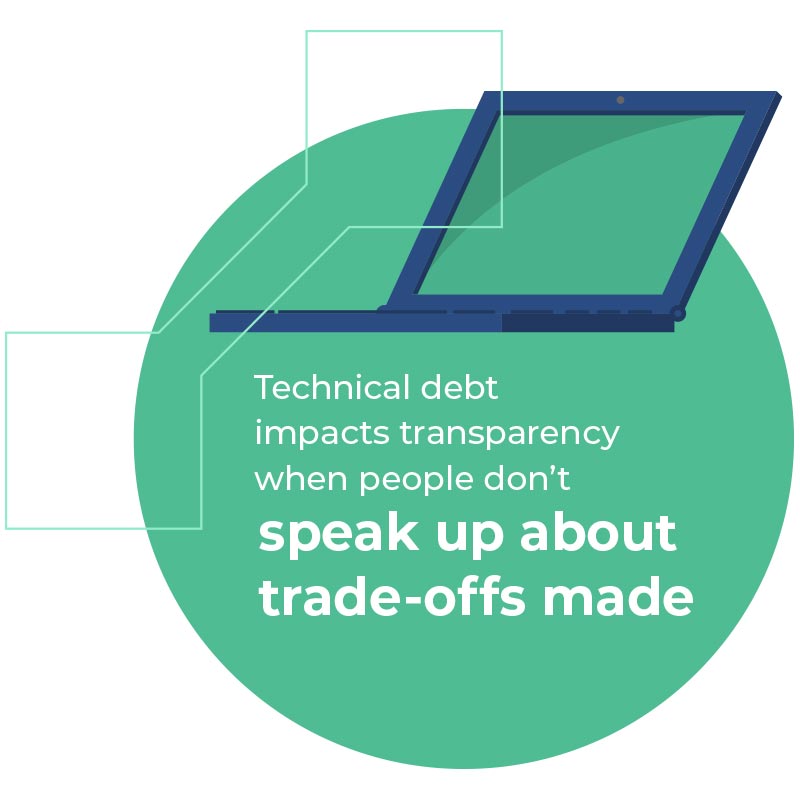
If your organization and all stakeholders don't understand that you're making those trade-offs, then you’re faced with a fundamental lack of transparency. That’s why technical debt is such a hot topic for the association world.
In fact, the biggest barrier to bringing innovations to market at speed and within budget are accumulated trade-offs made between time, cost, and quality when implementing technology.
Mountains of debt can make it difficult to engage in digital transformation and take on the next big endeavor that technology can enable. In turn, you’re prevented from making real progress and taking your organization and its mission to the next level.
Tackling technology problems
Whether they’re preventing you from upgrading your systems and engaging new members, or they’re making you less responsive and agile, technology problems radically get in the way of fulfilling your strategic plan.
Are you struggling to crawl back up the rabbit hole of technical debt? Ready to take the path forward instead of falling into the dark abyss?
At Cimatri, tackling technical waste is a central part of our business model. We help you develop a strategy for approaching your technology stack and ensure you have the right people, processes, and technologies in place to not just avoid technical debt but to accumulate technical equity in the form of improved agility, innovation, and ability to scale.
Are you ready to solve your IT issues and get your technology to work for you? Use our comprehensive assessment The Works to get a plan in place.



